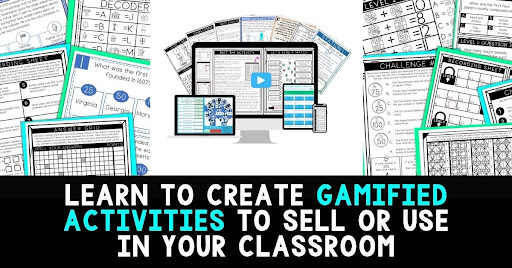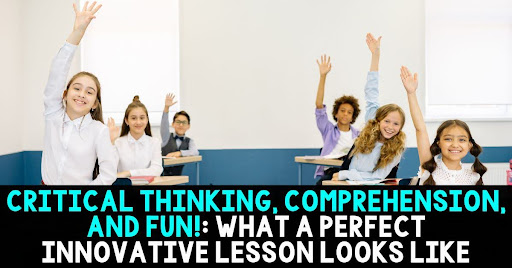Escape Room FAQS
Your questions: answered!
Do you feel daunted or overwhelmed when you think about trying an escape room activity with your class?
Have you ever tried an escape room or a similar activity with your students, and it all seemed to fall apart?
If you answered yes to any of those questions, this post is for you!
Today, I’ll answer any lingering questions or address any hesitations you might have when it comes to using escape rooms in the classroom. I’ll also provide some insider tips to ensure that you and your students are successful in using these highly engaging learning activities!
What’s the big idea? Reviewing the definition and purpose of the escape room
Let’s start by reviewing what an escape room is, and why you should use escape rooms with your students!
“Traditional” escape rooms involve a group of people trying to solve a variety of puzzles in order to open a lock that allows them to “escape” from the room. The activity is usually timed, and is often used as a fun team-building activity for friends, coworkers, or family members.
Escape rooms in the classroom are meant to provide your students with a challenging and exciting way to interact with important content. In the <<Think Tank teacher shop>>, I have escape rooms for all kinds of topics in Social Studies, Science and Math.
I like to use digital or printable escape rooms that don’t ask the teacher to create or buy anything extra (unless you just want to!) All the escape rooms or puzzle activities in my store are print-and-go resources to make your life easier!

Check out more of my blog posts about escape rooms, such as this one about <<Math>> or this one about the effectiveness of digital escape rooms! Then, browse around the Think Tank store to find escape rooms that cover important topics in your curriculum such as the causes of the Revolutionary War, Human Body Systems, and Ancient China.
Our goal with escape rooms is not only to ensure that students learn the particular content but also to develop a variety of essential skills along the way.
Skills such as problem-solving, time management, critical thinking, listening, turn-taking, and general team-building strategies can enable students to be successful not only in school but in the real world outside your classroom doors as well!
My number one tip for using escape rooms is to keep these goals in mind! If we can remind ourselves and our students to embrace the challenge, then it becomes more worthwhile to persevere through any obstacles we might face! It’s
Common Questions About Using Escape Rooms in the Classroom
Although my escape rooms and puzzle stations are among my most beloved and bestselling resources in the Think Tank Shop, I tend to get the same questions from teachers who are thinking about using the resources. Here are the answers to 9 common questions about using escape rooms in the classroom. If you happen to think of more questions or concerns, always feel free to reach out!
How long will this take?
I designed the activities to last for about 45 minutes, although this depends on the age of the students and the size of the group. Students might get faster at solving the puzzles with more frequent use, which is great!
If it’s your first time trying an escape room, I recommend building some time in at the beginning to explain the purpose of the activity. Additionally, it will be helpful to debrief at the end of the activity. What went well? What can we do better? What was difficult?
Lastly, don’t let your students constantly ask you for the answers! Remind them that it’s OK to struggle a little bit, and that with hard work they should be able to figure it out!
What do I have to prep? I don’t have time to cut out weird stuff or stuff envelopes!
While some DIY-style escape rooms require you to make your own locks, come up with your own puzzles, cut out shapes and stuff envelopes, etc., that is not what you’ll get with a Think Tank Teacher escape room or puzzle station set! My escape rooms require very little setup and NO cutting or stuffing envelopes 🙂
I can’t figure out one of the puzzles, help?!?
All of the escape rooms have either hint cards or “how to” sections to offer assistance. And if you’re still stuck, I’m just an email away!
Should I use this as a review activity or as an introduction to the unit?
I prefer to use them as an intro to really hook the students, get them excited about learning, and provide them with an overview of some of the concepts or vocab words they’ll be learning.
With a hands-on, appropriately challenging activity such as an escape room, you’ll pique student interest from the start! Once you have their attention, they’ll be better equipped to dive deeper into the content of your unit. If you’d like to learn more about using hooks to engage students from the start, check out this post.
What’s the best way for students to work through the escape room (independently, in groups, or in partners)?
I personally have found the most effective strategy is partner work. This way if kids get stuck they can bounce ideas off of one another. If you choose to do groups, just keep the group small. Larger groups tend to lead to less engagement and/or one student doing most of the work.
Is this too hard for my 5th-grade students?
Give them a chance! Kids are smart and remember, the whole goal is to allow them to use their critical thinking and deductive reasoning skills. More often than not, a teacher who “thought” it was too difficult for students was blown away by the kids’ engagement and puzzle-solving skills once they got started! This is meant to be a challenge. Focus on developing a <<growth mindset>> and encouraging kids that we can do hard things!
Will my lower-level learners be able to complete these?
Absolutely! Often you’ll find your most reluctant or shy learners come out of their shell and shine. Additionally, if you allow students to work in partners or teams, different students can bring their different strengths to the table in order to allow the whole group to be successful.
Some of the escape rooms use the same “type” of puzzle. Why?
This is on purpose. We want students to be able to focus on the content, not spending excess time learning how to do a new type of puzzle.
How are yours different than other escape rooms I see on TpT?
Too many teacher authors call their activity an “escape room” but all students are doing is answering multiple choice questions on different worksheets and maybe doing a word search. In that case, there is no puzzle solving, no ciphers, just very basic 4 digit code answers.
I like to intertwine reading comprehension with answers that need to be decoded. They hold educational value and are not just a fun activity to do as a reward or the day before a break when kids are going stir crazy.
So if you’re on the fence about using escape rooms, jump in! Take a look at the escape rooms in the Think Tank Teacher store, and you’ll be sure to find what you need. I personally love these Reading and Puzzle Escape Rooms to ensure kids are practicing reading comprehension skills. Trust me, you love seeing your students grow as critical thinkers, problem solvers, and content experts!
Want to learn how to create your very own escape room? Learn more about the Teacher Template Toolbox by adding your name below:






